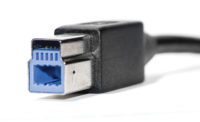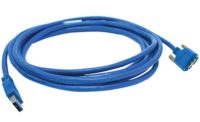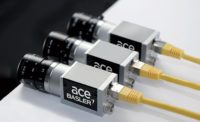Vision Interfaces 101
As resolution and frame rates increased over time, so have the requirements for camera interfaces.

Various camera interfaces have been developed for the machine vision industry’s need for high speed imaging.

Released in 2006, GigE Vision using Ethernet became a widely adopted machine vision camera interface.

The USB3 Vision standard, introduced in 2013, has become a cost effective interface for the machine vision industry.





Since the inception of industrial machine vision cameras, various camera interfaces have been developed to meet the needs of the camera manufacturers. Many of the consumer market interfaces like Firewire, USB and and Ethernet were created for standard peripheral or networking use. Other interfaces like Camera Link and CoaXpress were developed specifically for imaging since no other interface provided the necessary throughput required for high speed imaging.
As resolution and frame rates increased over time, so have the requirements for camera interfaces. While the machine vision industry has adopted GigE and USB as the primary interfaces for imaging, we’ll explore at a high level the most common interfaces used throughout industrial imaging and touch on the future of USB and GigE.
SPECIALIZED CAMERA INTERFACES
The first camera interface used in the beginning of digital machine vision was Firewire (IEEE1394-DCAM). This interface, developed by Apple, became popular for many industrial computers and camera vendors since there was no other standardized interface for machine vision. Camera Link, the first true machine vision interface and standard, was introduced by AIA in 2000. This original standardized interface introduced a common cable type to connect the camera to a frame grabber on the host device. The frame grabber is a piece of hardware that is added to the computing platform and is responsible for capturing the streaming control and image data to and from the camera. More advanced frame grabbers can also manage audio input, work at higher frame rates and resolutions, and manipulate the incoming image frames, performing image transformations or compression.
Through the use of a suitable frame grabber, Camera Link can capture image data at a maximum throughput of 255 MB/s over a single cable and 850 MB/s over two cables. The maximum cable length supported by this standard is 10 m for transmission rates up to 510 MB/s and 7 m for 680 MB/s and above. Camera Link also allows for up to 4 W of power to be made available to the camera per connected cable. However, the Camera Link cables are bulky with limited flexibility and more expensive than USB, Ethernet or Coaxial cables.
Ten years after the advent of Camera Link, an alternative interface using frame grabber technology was introduced. CoaXPress was created to bring a significant increase in throughput to systems using frame grabbers. Up to 600 MB/s over a single cable is possible with this new interface, and up to 6 coax cables can be combined into one cable to deliver 3600 MB/s of image throughput. CoaXPress can also deliver 13W of power per individual coax cable. Maximum cable lengths vary depending on the type of cable used as well as its diameter, but at this time they can reach distances of up to 35 meters at the highest data rates. Other innovations introduced by CoaXPress include error detection, camera-based hardware triggering, and compatibility with repeater devices to transmit to multiple receivers.
STANDARD COMPUTING INTERFACES
To reduce system costs, standards were developed using common computer interfaces while removing the need for costly frame grabbers and specialized cables. Since these interfaces are designed to connect to a variety of peripherals, they are familiar to any user and are generally ubiquitous across many computing platforms.
The GigE Vision standard (released in 2006) is a widely adopted camera interface developed using the Ethernet communication standard (IEEE 802.3). The interface’s 115 MB/s throughput speed is attainable without the use of a frame grabber, and can span distances of up to 100 meters with a single cable. Using Power over Ethernet (PoE), each cable can deliver up to 25W of power.
The GigE Vision standard supports the link aggregation (LAG) of two cables to a single camera, simultaneously doubling the connection speed and power delivery. It also allows for networking capabilities for integration into existing Ethernet switches for varied topologies. GigE Vision supports errored frame detection and retransmission in the event image data becomes corrupted.
When it comes to USB, one of the most popular computer interfaces in the world, a significant evolution introduced a substantial increase in speed in 2008. Going from USB 2.0 at 60 MB/s to 10 times the speed with USB 3.0 at 625 MB/s, USB 3.0 became an attractive interface for vision systems for its speed and plug-and-play nature. The USB3 Vision standard was introduced by the AIA in 2013 while building on the USB 3.0 technology available today to make a cost effective interface solution for the machine vision industry.
Standard USB 3.0 cables can span up to five meters in length. In many machine vision applications, this has been considered a fixed limitation, however this shortfall has been addressed through the ongoing introduction of active cables with embedded electronics, capable of spanning up to 100 meters. Standard USB 3.0 power delivery of 4.5W applies to passive cables and variable amounts of power delivery are possible through active cables.
USB 3.0 supports Direct Memory Access (DMA) which minimizes CPU usage while transferring large amounts of data to the hard drive. This can result in cost reductions, in comparison to GigE, for host computing systems needing the processing power for analytics or handling multiple cameras per system. Minimal signal latency with USB 3.0 is also another significant benefit when dealing with the software synchronization of cameras and other devices compared to the jitter that can be apparent with GigE interfaces.
FUTURE INTERFACES
Going forward, USB and GigE will continue to build on their respective success and will introduce new transfer mechanisms to deliver higher throughput speeds as camera resolution and frame rates increase. For the Ethernet realm, a move towards ten gigabit Ethernet is already available but at the expense of complexity and heat. Ten GigE boasts speeds of 1,100 MB/s and distances of 5,000 meters through the use of costly single mode fiber optic cables.
There are also some proponents looking to develop NBase-T Ethernet cameras, where the interface can use existing Cat5e/Cat6 Ethernet ports to achieve speeds of up to 625 MB/s, without taking into account protocol overhead. NBase-T also has the ability to use low-cost standard copper Ethernet cables, which allows for the use of PoE while taking advantage of bandwidths five times greater than that of GigE.
USB 3.0 evolves gracefully to the USB 3.1 protocol, improving its encoding algorithms to only 3% overhead and increasing its throughput to over 1,200 MB/s. These improvements will be attainable through existing USB 3.0 cables as there is no change of the mechanical specification to upgrade to USB 3.1. For higher power requirements, it can also incorporate the new Type-C connector, capable of delivering up to 100W of power from the host computing platform to the peripheral. V&S
Looking for a reprint of this article?
From high-res PDFs to custom plaques, order your copy today!









